Canon Digital Ixus 860IS / PowerShot SD870 IS Digital Elph
-
-
Written by Gordon Laing
Canon Ixus 860IS / PowerShot SD870 IS design and controls
Canon’s Ixus 860IS / PowerShot SD870 IS is a smart-looking, metal-bodied compact which combines style with decent construction. We’ve pictured it below on the left alongside Panasonic’s Lumix DMC-FX33, an equally classy compact with 8.1 Megapixels. Measuring 93x59x26mm, the Canon is around the same width as the Panasonic, but 7mm taller and 3mm thicker. It’s noticeably chunkier in your hands than the Lumix FX33, but at 180g including battery, shouldn’t place a strain on most pockets.
Like most compacts these days, there’s nothing obvious on the front to act as a grip, but a curved ridge running the full height of the camera alongside the screen acts as a very effective thumb rest, while the Canon logo on the front prevents your middle finger from slipping. It’s a clever design which allows you to hold the camera comfortably and securely.
The overall design and build quality is excellent, although we noticed the front surface could collect fine scratches quite easily. If you’d like to protect the camera from particularly rough conditions though, consider the optional WP-DC17 underwater housing which can operate to depths of 40m.
The top surface from left to right houses the loudspeaker, a three-way switch to select between movie, scene and normal shooting modes, the on / off button, and a shutter release button surrounded by a zoom rocker. The small dot just to the front of the power button is the microphone.
The rest of the controls can be found to the right of the screen round the back. Four large buttons are dedicated to Play, Direct Print, Menu and Display options, and in the middle is what looks like a standard circular four-way rocker with a Function / Set button in the middle.
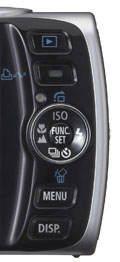 |
As you’d expect, this rocker can be pushed up, down, left or right to adjust certain settings, and in the case of the 860IS / SD870 IS, these offer direct access to the ISO, flash settings, self timer / drive mode, and macro mode. As you go to push this rocker though you’ll notice it responds to a light touch, enlarging a graphic on-screen to indicate what setting will be adjusted if you push it all the way-in.
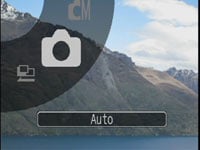 |
Cleverer-still, the circular edge of this control can be used as a touch wheel, cycling through shooting modes or other options as you run your finger or thumb around it. If you’re taking photos, the wheel allows you to change the mode as if you were turning a physical dial, and a graphical representation is shown in the top left corner of the screen.
The touch wheel sounds great in theory, but as you’ll see in our video tour, it can take some practice. Get the pressure wrong and you’ll be adjusting the self timer instead of changing the shooting mode for instance, or ease up at the wrong moment and you could find yourself in the wrong mode. Recognising this, Canon sensibly allows you to alternatively select the shooting mode via the super-imposed Function menu instead, and in use we found ourselves using this technique much more often than the wheel.
Canon Ixus 860IS / PowerShot SD870 IS Screen and menus
Canon splits the settings between three tabbed menus and its super-imposed function system for the more common options, depending on the current mode. Press the Func / Set button in the middle of the circular rocker and the relevant settings are shown running down the left side of the screen from top to bottom. As you scroll through these settings, their options appear in a bar running horizontally along the bottom. In use it’s quick and effective, and we have a demonstration in our video tour.
With the top switch set to normal shooting and the mode set to Manual, you can adjust the exposure compensation, white balance, My Colours options, the metering, image compression and resolution. The 860IS / SD870 IS offers shutter speeds from 15 seconds to 1/1600, but sadly no direct means for you to manually adjust them or the aperture even in the ‘Manual’ mode.
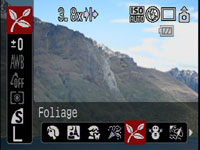 |
Set the mode switch to SCN and you can select between ten presets. Set the switch to Movie and you can choose between five modes including a time-lapse option which we’ll talk about on the next page.
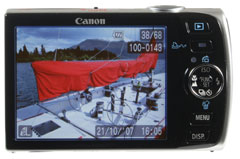 |
The 860IS / SD870 IS is equipped with a superb quality 3in screen with 230k pixels. This occupies almost the entire rear surface of the camera which means there’s no longer room for the optical viewfinder of its predecessor. While a shame to lose it, Canon has at least pulled out all the stops on the screen. In use it looks excellent and is one of the best we’ve seen. Despite having the same number of pixels as many 2.5in screens, the image also never looks coarse.
Press the DISP button and you can toggle between a clean view of the composition, or one with shooting details, but strangely no grid or live histogram. Like most Canon compacts, the former is activated from a menu, but sadly on the 860IS / SD870 IS there’s no live histogram option – a shame considering it’s higher-end credentials.
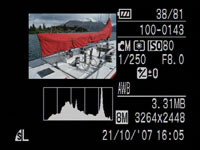 |
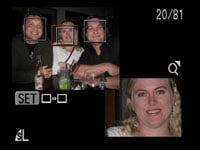 |
Offering some consolation though is a brightness histogram in playback. Better still is the option to view an enlarged portion of the active focus point in the photo – this can be very handy if the photo was taken with face detection as you can quickly cycle through close-ups of the faces to see if anyone blinked – again we have a demo in our video tour. Finally, like most Canon compacts, physically turning the camera during playback rotates the image which is handy for filling the screen with a portrait aspect shot.
Canon Ixus 860IS / PowerShot SD870 IS Battery and connectivity
The Canon 860IS / SD870 IS is powered by a 1120mAh NB-5L Lithium Ion battery pack and is supplied with a mains recharger. Canon estimates 270 frames under CIPA conditions, although under heavy use, especially using features like the time-lapse mode, you may only get around half this amount. So as always, a spare is advisable, as is carrying the charger on trips with you.
The battery is housed in a compartment accessed from below the camera. Like most compacts, this is also where you’ll find the memory card slot – an SD in this case – and as usual, access to both it and the battery are blocked when mounted on a tripod. Finally, behind a flap on the right side of the camera are separate USB and TV output sockets.




